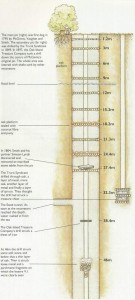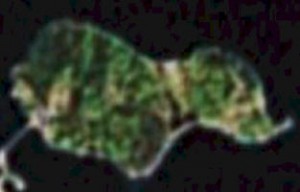By Brent Raynes: Keith Ranville of Vancouver, British Columbia, is a Cree Indian who was born in Winnipeg. Keith has brought a new perspective to the legendary Oak Island mystery of Nova Scotia’s Mahone Bay area, and it’s probably about time. I first read about this mystery myself in Stranger Than Science by Frank Edwards back in the late 1960s.
Cree Code Breaker Keith Ranville and the Oak Island Money Pit Mystery
213 years have passed so far and no one has yet to recover the pirate treasure that so many feel is buried beneath the earth there. Over the years, many people have attempted to translate mysterious symbols reportedly copied from two different stones on the island. Hoping to isolate some vital clue or insight into how to retrieve the treasure that is believed to be buried there.

In a statement posted on the Internet two months ago, Keith Ranville was quoted: “I believe these symbols have been incorrectly assumed to stand for something else.
In the First Nations tradition that I’m a part of, we believe symbols should simply be looked at in and of themselves. Rather than thinking of them as codes that have to be cracked. In the pictograms of Cree Salavics, for example, the images are meant to be descriptive, not abstract.”
Keith Ranville – Oak Island Money Pit Research
Keith noticed the use of triangles from the stone symbols to be a recurrent and possibly a significant theme. “The triangles seemed like they were more emphasized,” he said. “The first line of the symbols were mostly triangles.
I got the idea that this thing was mostly about triangles and so I began to look for triangle clues on the island itself. There was one triangular clue, a stone triangle, that was found south of this so-called ‘Money Pit.’”

He looked on google at aerial photos of the island and he went east of that stone triangle that was there. Because on the symbols itself there was an arrow that pointed at the right angle of a triangle, the fourth and fifth symbol. So he went in that direction and looked everywhere there east on the island.
He didn’t see it, so checked on a neighboring island, and sure enough a big triangle popped out at him from Birch Island. It was a section of the island that had a triangular appearance.
Speaking of triangles, Keith made another discovery. “I found something while doing Internet research that actually talks about the significance of triangles in Micmac language,” he noted. “It actually means something like God and in Egyptian it means ‘exalted one.’
That’s off of petroglyphs of the Micmacs and their writings. So that really fascinated me too because the Micmac are native to the Mahone Bay area. If anyone is going to know about this Oak Island Money Pit mystery it’s going to be the Micmacs because it’s in their back yard.”
Keith Ranville – Oak Island Money Pit Research

Three young men discovered this vertical shaft entrance back in 1795. They believed it led to a pirate treasure. Countless man hours have been spent, and, over the years, it has exceeded ten million dollars in cost. Just to try and get to the proverbial bottom of what has become known as the “Money Pit.” Not to mention the tragic loss of human life. So far the lives of six men have been lost.
In 1803, the Onslow Company, which had become the first in a long line of treasure recovery operations, discovered at the 90 foot level a flat stone with a strange inscription on it. Reportedly weighing about 175 pounds, measuring two feet long and 15 inches wide, a translation attempt was made by one James Leitchi, a professor of languages at Dalhousie University. He thought it perhaps read, “forty feet below two million pounds are buried.”
Flagstone translation by Keithe Ranville
“The thing with Oak Island Money Pit is that it has always been a controversy,” Keith explained to me. “There was so much lost evidence and there were like no significant well documented archaeological finds. It seemed like one thing was bungled up after another.” Yes, unfortunately the inscription stone eventually became lost.
We’re told that it became used as a hearthstone in two homes on Oak Island. Then it was placed in a Halifax store front where it went missing around 1900 after the building was torn down. However, the two line and forty-character text was reportedly copied and thus preserved by a Mahone Bay schoolteacher who had hoped that he could translate it.

Meanwhile, back in the 1930’s, the fragment of another stone, with similar symbols on it, turned up at Oak Island’s Smith Cove, though it also had a symbol that was different. “It could be Greek,” Keith explained. “I’m not too sure if it is. But four dots and a plus in the middle in Greek means ‘underwater doors.’ I think that around the 100 foot level, the area where the treasure stone was found, they should not have gone any farther.” Reportedly the mine shaft goes down nearly 200 feet now.
“There’s supposed to be another dig going on this summer,” Keith added. “They figure that there’s like a Spanish treasure down there.” So far, fragments of a gold chain have been found, and a camera lowered down into the pit in 1971 reportedly recorded images of wooden chests and human remains.
Keith Ranville – Oak Island Money Pit
“It seems more like a spiritual quest than a treasure hunting quest,” Keith confided. “For me to come up with all of these possible and plausible solutions to Oak Island intrigues a lot of people as to how this native guy, out of nowhere, comes to Oak Island, to Nova Scotia, and people are willing to write articles and letters of support. I’ve been on the radio numerous times.”
In the summer of 2005, Keith traveled to Nova Scotia and spent a year looking into the Oak Island mystery. “I think what most people are intrigued by is how I got there because anyone can jump on a plane and go to Nova Scotia and then come back,” Keith told me. “I got there pretty much on my wits. I hitchhiked most of the way and took a bus a little bit of the way.
I rested out in Winnipeg first, for a week or so, and then I continued on my journey. I guess Winnipeg was like the halfway mark. I went from city to city. I talked to many people. I talked to the Freemasons and they’re pretty intrigued with what I was saying about Oak Island. For some reason, I felt a need to talk to them. I have no desire to become a Freemason myself.”
Oak Island Money Pit – Keith Ranville
Keith recalled when he was in high school he was going to do a paper on the Oak Island Money Pit mystery. He didn’t get to hand it in because there was a death in the family. But he remembered the original concept he had perceived on translating these symbols back then but didn’t follow up on it until years later, until he was in my mid-thirties.”
“I believe it was a universal written language. I feel that it was something made to be understood no matter what culture you are from or what language you speak. It wasn’t something made for just one creed of person or a certain group of people to understand. It was meant for anyone.” “I believe that there may be a Mayan connection to this, for some reason,” Keith added. “Just by the way that the stones of this triangle were lined up. It just gave me that feeling that this was Mayan, and especially with the symbols themselves.”
Keith also gets insights sometimes in his dreams.
Keith Ranville welcomes feedback from our readers. His email address is: keith_ranville@hotmail.com
Check out his website: http://keithranville.wordpress.com/
Courtesy of Alternate Perceptions Magazine